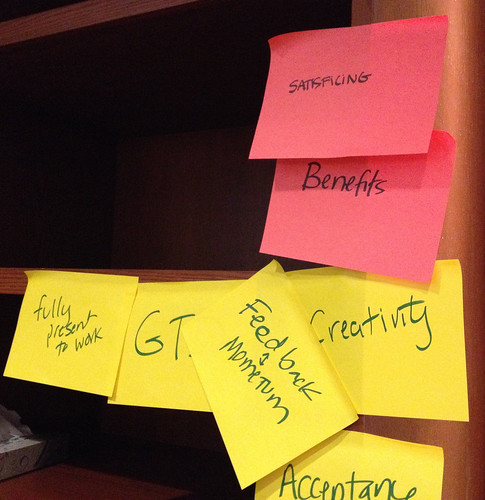
Last November, I had the opportunity to have a conversation with Erie Ries, Lean Start Up, about applying the principles to nonprofits. He talked about how perfectionism, an internal mindset that bad things in the world will happen if our campaign, program or whatever is not right from beginning. Perfectionism is the enemy of learning and ultimately of getting improved impact. “We live in a culture of high quality and low risk tolerance and people want to be safe and not harmful. We have to look at perfect vs fast. If you go slower, you get less feedback and that won’t help you build a better product or program. You need to iterate towards perfection based on audience or stakeholder or customer feedback.”
So, here’s what happens though … nonprofits embrace the technical part of learn: testing with metrics without first addressing the culture of perfectionism and understanding how this way of being in the world gets in the way. I think a reflective look at our own inner perfectionism and how it permeates our work culture is needed. If we don’t understand this, then all we do is try to design the perfect experiment (one that is way too complex and takes many months to complete). Learning how to design effective fast experiments is something that we also have to iterate on. I’ve learned this from personal experience!
If in our first attempt at designing an experiment ends up producing one that does not give us insights, or we realize that we were measuring the wrong thing, we can’t just say “it didn’t work” and revert to our old ways or blame others. We have to get rid of our perfectionism, and iterate on our design and try it again! One thing that Eric Ries said that understanding the single metric that matters and what to measure is something that takes can a long time to get to.
I came across this wonderful 99U article called “Satisficing.” The opposite of “satisificing,” is when we try to make everything we do awesome, an A+, the best we’ve ever done, or plow through all the many tasks on our to do lists or answer every email. Satisficing is the act of stepping back and stopping that perfectionism behavior – and feeling that good enough is okay. Many people who work in the nonprofit sector are driven by passion for their work because we are doing good and many of us share being over achievers. So, it is hard for us not to give our complete energy, even at the expense of our well-being and stressing ourselves out.
The article offers several tips for applying “Satisficing” in general to our lives:
1. Accept you won’t get everything done
2. Keep a new ideas journal and don’t feel like a failure if you don’t implement everything
3. Prioritize your well-being
4. Ship early, than iterate
That last point, of course, resonates with lean start up principles. The article suggests that we in our work, we should avoid aiming for brilliant out of the gate, do the basics and then recognize that with almost anything in our work, we can refine, edit, and iterate. Why is it so hard for nonprofits to work this way?
Why not have an experiment that puts satisficing to the test. Create a hypothesis about the amount of time it takes to do a work task and see if anything bad happens if you invest less effort or time. What if you cut the time for meetings from 60 minutes to 30 minutes for a week, would you get through the agenda? Maybe you learn something about how much at 60 minute meetings is wasted because you scheduled it for 60 minutes or maybe something about designing a more streamlined agenda. What if we looked at different organizational work processes and tested a more streamlined approach. Does that blog post actually need 10 revisions and 6 approval chains?
I recently had the chance to discuss “satisficing” with group of really smart people who work for a nonprofit organization. We talked about the benefits and fears of applying this mindset to work. We talked about how liberating this can be – giving permission to do less – that it creates space for creativity. You also feel more empowered because you are getting things done and that creates momentum. And, it also generates a feeling of acceptance and love of other people on your team. It can be hard to make this shift, and small experiments might help with making it feel more comfortable and not “slacking off.”
The concern of course is applying it in an organizational context. What is the organizational standard of “good enough.?” What happens if you practice satisficing but others think you are just aren’t doing a good job. This is part of the culture change, getting around on the same page about the ship early and iterate approach. Good enough is also a very subjective. Of course, organizational leaders of to model this mindset and people in the organization have to practice it. It takes patience and discipline to change a culture but it has many rewards.
I’m trying to apply this to my own work and it isn’t the easiest thing in the world. How have you applied the “satisficing” to your work for your nonprofit? Is it part of your organization’s work culture or viewed as “slacking.?”
Beth Kanter is a consultant, author, influencer. virtual trainer & nonprofit innovator in digital transformation & workplace wellbeing.
